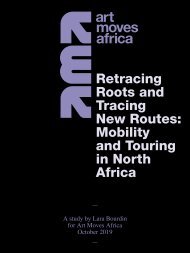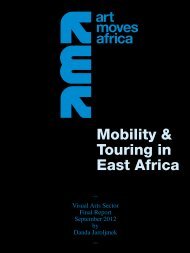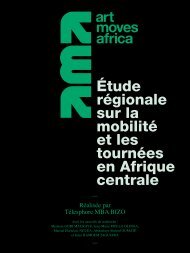Art Moves Africa – Retracing Roots and Tracing New Routes: Mobility and Touring in North Africa
A study by Lara Bourdin for Art Moves Africa, October 2019
A study by Lara Bourdin for Art Moves Africa, October 2019
- No tags were found...
You also want an ePaper? Increase the reach of your titles
YUMPU automatically turns print PDFs into web optimized ePapers that Google loves.
38<br />
Summary of Outcomes<br />
—<br />
3.<br />
LACK OF INTEREST OR MOTIVATION /<br />
PREFERENCE FOR TRAVEL TO EUROPE<br />
—<br />
When asked why they thought mobility is weak with<strong>in</strong><br />
the region <strong>and</strong> especially with respect to other <strong>Africa</strong>n<br />
regions, most respondents noted that artists <strong>and</strong> cultural<br />
operators associate mobility with travel to Europe.<br />
Aggravat<strong>in</strong>g factors <strong>in</strong>clude:<br />
a) Europe’s geographical proximity: some respondents<br />
noted that Europe felt “closer” than<br />
the rest of the <strong>Africa</strong>n cont<strong>in</strong>ent.<br />
—<br />
QUOTE:<br />
« Ever s<strong>in</strong>ce the Barcelona process,<br />
<strong>and</strong> all the other measures taken<br />
to regionalize the Mediterranean,<br />
to make it a geo-politico-cultural<br />
space, artists have <strong>in</strong>creas<strong>in</strong>gly<br />
wanted to travel <strong>North</strong> rather<br />
than South. »<br />
Malek Sebaï<br />
Dancer <strong>and</strong> choreographer,<br />
co-founder, Associations Danseurs<br />
Citoyens <strong>and</strong> Hayyou’Raqs, Tunis*<br />
—<br />
b) Lower costs for travel to Europe make it<br />
possible for <strong>in</strong>dependent cultural actors to<br />
cover travel costs themselves <strong>in</strong> the absence<br />
of mobility fund<strong>in</strong>g (although this avenue is<br />
be<strong>in</strong>g jeopardized by visa restrictions).<br />
c) <strong>Art</strong>ists’ precarity <strong>and</strong> the precarity of the<br />
arts sector underlie many aspirations to a<br />
European career.<br />
d) Regionalization of the Euro-Mediterranean space <strong>and</strong> separation<br />
of “<strong>North</strong> <strong>Africa</strong>” <strong>and</strong> “Sub-Saharan <strong>Africa</strong>,” namely through<br />
fund<strong>in</strong>g agendas (see Introduction & Methodology, Key terms).<br />
e) The relative weight traditionally held by bilateral cooperation<br />
<strong>in</strong>stitutes <strong>in</strong> facilitat<strong>in</strong>g mobility projects.<br />
f) More plentiful tra<strong>in</strong><strong>in</strong>g opportunities <strong>in</strong> Europe <strong>and</strong> the associated<br />
prestige.<br />
g) Misconceptions about everyday life <strong>in</strong> Sub-Saharan <strong>Africa</strong>: some<br />
respondents noted that Sub-Saharan <strong>Africa</strong> is associated with<br />
poor work<strong>in</strong>g conditions <strong>and</strong> uncomfortable accommodation, if<br />
not war <strong>and</strong> disease, <strong>in</strong> the more extreme cases of misconception<br />
<strong>and</strong> prejudice (see #4, Difficulty Identify<strong>in</strong>g With <strong>Africa</strong>n<br />
Identity / Discrim<strong>in</strong>ation).<br />
h) Misconceptions about the arts sector <strong>in</strong> <strong>Africa</strong>: some respondents<br />
reported that artists <strong>and</strong> cultural operators <strong>in</strong> their<br />
milieus believed that noth<strong>in</strong>g happens <strong>in</strong> <strong>Africa</strong> <strong>in</strong> terms of arts<br />
<strong>and</strong> culture.







